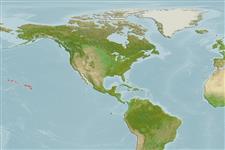>
Anguilliformes (Eels and morays) >
Ophichthidae (Snake eels) > Myrophinae
Etymology: Scolecenchelys: Greek, skolex = worm (1855) + Greek, enchlys, -yos = eel (Ref. 45335).
Eponymy: Dr Charles Montague Cooke Jr (1874–1948) was a malacologist at the Bishop Museum, Hawaii and Curator of the snail collection (1902–1948). [...] (Ref. 128868), visit book page.
More on author: Fowler.
Environment: milieu / climate zone / depth range / distribution range
Écologie
marin démersal; profondeur 3 - 5 m (Ref. 58302). Temperate
Eastern Central Pacific: Hawaii (Ref. 27116).
Taille / Poids / Âge
Maturity: Lm ? range ? - ? cm
Max length : 15.5 cm TL mâle / non sexé; (Ref. 28618)
Benthic in sand pockets among coral (Ref. 58302).
Life cycle and mating behavior
Maturité | Reproduction | Frai | Œufs | Fécondité | Larves
Castle, P.H.J. and J.E. McCosker, 1999. A new genus and two new species of myrophine worm-eels, with comments on Muraenichthys and Scolecenchelys (Anguilliformes: Ophicthidae). Rec. Aust. Mus. 51(2-3):113-122. (Ref. 40863)
Statut dans la liste rouge de l'IUCN (Ref. 130435: Version 2024-2)
Menace pour l'homme
Harmless
Utilisations par l'homme
Outils
Articles particuliers
Télécharger en XML
Sources Internet
Estimates based on models
Preferred temperature (Ref.
123201): 24.5 - 25.6, mean 25.3 °C (based on 34 cells).
Phylogenetic diversity index (Ref.
82804): PD
50 = 0.5000 [Uniqueness, from 0.5 = low to 2.0 = high].
Bayesian length-weight: a=0.00076 (0.00029 - 0.00197), b=3.06 (2.83 - 3.29), in cm total length, based on LWR estimates for this (Sub)family-body shape (Ref.
93245).
Niveau trophique (Ref.
69278): 3.8 ±0.7 se; based on size and trophs of closest relatives
Résilience (Ref.
120179): Haut, temps minimum de doublement de population inférieur à 15 mois (Preliminary K or Fecundity.).
Fishing Vulnerability (Ref.
59153): Low vulnerability (10 of 100).
